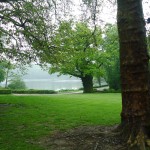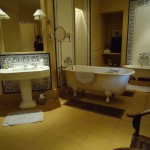It is the perfect setting for a murder mystery. After some fairly tricky driving, we found our way to Chateau de la Verrerie, the Glass Castle, http://www.chateaudelaverrerie.com, situated next to a misty lake deep in the Berry, a department in the Loire south of Paris. Seemingly, we drove forever through flowering fields, having veered off the main road 30 kilometres north of the medieval town of Bourges (an interesting stop to be covered in another blog.) Suddenly we were upon it, a 15th century castle with all the turrets, sculptures, mullioned windows, frills and furbelows one could wish in such a structure.
Set in an oak forest, La Verrerie has a fairy tale quality. Huge trees line the approach as we drive in next to the mysterious lake. A short spurt through the turreted gatehouse arch and we are there. The castle’s origins actually date back to 1422. The name, the Glass Castle, came from a small glass factory next to the lake which was demolished in 1815, but the name stuck.
The Chateau is on the Route Jacques Coeur, en Berry, http://www.route-jacques-coeur.org. I knew nothing of Jacques Coeur before my first visit to this region but now know he was a fifteenth century adventurer who became a trusted financial advisor to King Charles VII. The Jacques Coeur route has been put together as a driving tour, visiting Coeur’s many houses in the region and allowing tourists to experience the best of the Berry, itself a somewhat undiscovered French region, particularly to Americans. It has the full complement of French chateaux, charming villages, vineyards and the great wine village of Sancerre – plenty for any eager traveller to see.
At the castle entrance, we were ushered into a great oak door and foyer. Our luggage was quickly carried up two massive flights of stairs to our chamber, one of seven available for overnight stays. The room itself was beautiful, with 15-foot ceilings, walls, chairs, draperies and bedspreads all covered in the same sprigged flowered pattern, antique furniture and a bathroom larger than many apartments in Paris or New York City.
Venturing downstairs, we enjoyed a private tour of the castle itself – learning about the centuries of history encompassed in this one house.
Once upon a time there was Louise de Kéroualle, a beautiful young woman from Brittany. Somehow she had a friendship with King Louis XIV and became the King’s spy at the Court of Charles II of England. Being quite enterprising, she struck up a similar friendship with Charles II, diverting a tad from her spying duties. She bore Charles a son who became the Duke of Richmond. Somewhere in this scenario, this house came into the picture. The descendants of Louise and her son work their way down through the centuries, even becoming entangled with the Spencer family, ancestors of Princess Diana. Diana’s sons William and Harry and the forthcoming 3rd generation heir to the throne are all part of this story.
But wait, even with these generations of descendants, in 1842 the house and lands were sold to another elite family, the de Vogüés, who added the south wing which houses the reception rooms and most of the bedrooms. And it was the current owner, Count Béraud de Vogüé, with whom we met and had a long, cosy chat. The Count traces his family history back to the 11th Century, a simply amazing feat to any American. Clearly, he felt the press of historical ancestry as he pointed with pride to his framed family genealogy chart.
We wound our way through the grand rooms: the living room where musical evenings are held; the billiards room showcasing a fierce-looking dagger which is supposed to have slain a bear; the imposing dining room and, most interesting of all, the library, which holds Egyptian treasures brought back by one of Béraud’s ancestors who was an Egyptologist, and a perfect set of tiny lead soldiers, forever ‘frozen in their last charge.’* The house is filled with extraordinary antiques, of course, including a sedan chair belonging to Louis XV, and scads of Renaissance furniture. A great treasure of the house is four small figures of mourners carved in white marble, created for the tomb of Duke Jean de Berry in 1470. There were originally forty mourner statues but three centuries later they disappeared during the French Revolution. Just twenty-six have been recovered, 20 split between the Hermitage Museum in St. Petersburg and the Metropolitan Museum of Art in New York. Two others are in the Berry museum in Bourges. But here a Renaissance cabinet is discreetly opened and we gaze reverently at the backlit figures in awe. Each is completely different in stance, clothing, face and posture – we are two inches from them and they are priceless!
Coming down for dinner, we are ushered into a small salon, lined with books and art and furnished with deep sofas and chairs. Classical music is playing; drinks are set up along with snacks. Since the restaurant is closed this night, the chef makes us a so-called simple meal, a delicious combination of salmon and fresh asparagus with a lovely sauce, preceded by a perfect salad and exceptional bread and wine, (of course, this is France!), ending with a scrumptious lemon tart and tiny cookies. After a quick stroll outside, we dash through the freezing cold corridors to our warm room, sleeping straight through until breakfast, a sumptuous buffet of choices.
Perfect murder mystery fodder, right? I think I am going to give it a go!
*Quote from “The story of “La Verrerie” by Marc Frimat
Other references:
“La Verrerie, Le Château ou le temps se repose, by J. Frizot and Count Béraud de Vogüé, published by Histoire et Patrimoine, Victor Stanne Editions.
Note: Main Chateau photo from www.chateadelaverrerie.com; other photos by Merle Minda





One Comment